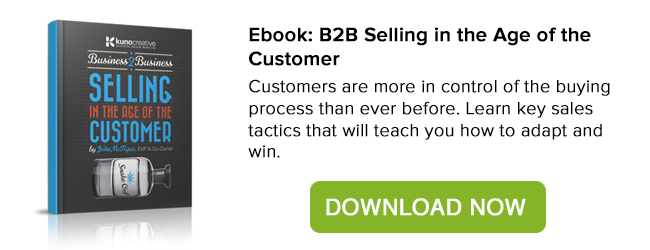 As we all know by now, you can’t just sell your products and services these days. It’s all about identifying buyer personas, attracting them with inbound content and nurturing them personally.
As we all know by now, you can’t just sell your products and services these days. It’s all about identifying buyer personas, attracting them with inbound content and nurturing them personally.
So we sales folks (hopefully) lock ourselves in a room with Marketing for a few days and hash out who our buyers are and what makes them tick. There’s the rub.
How many of us actually know what goes through the mind of a CEO, COO, CFO, CIO, CTO, etc.? If you haven’t walked the walk, you have no idea. You can pore over surveys and read best practices eBooks until you’re blue in the face, but getting into the heads of the C-Suite isn’t easy. I’ve been there, so let me offer a few tidbits of advice.
Think Committee
Unless you’re selling to a small business, chances are the purchase decision process routes through a committee of some sort. Here’s your challenge in a nutshell:
- Get to the Committee - you will most likely need to get the attention of one or more potential or current end users of your products and services first. You need to make them aware of their problem, if they aren’t already, and position your stuff as uniquely positioned to solve it. Inbound marketing is really good at this.
- Assist the End User - this is where Sales and Marketing Alignment comes in. Reps should be aware of the end user’s interest and behavior through marketing automation. Then the Sales Rep should make contact and help the end user understand how to get to and through the Committee to get the deal done. This helps to establish a relationship and brand advocacy. At this point, the end user will likely start seeking support among Management and work the system to get it done.
- Provide Valuable Insight - next up is arming the end user, now the brand advocate, with knowledge that she can present to the Committee. She will need to know how to answer the questions of each member, and they all have different agendas.
CEO
The CEO cares about driving the success of the company, period. Usually that involves creating the vision and goals for the company, building a solid Management Team and holding everybody accountable for reaching those goals. The CEO thinks about revenues and costs and watches financial statements like a hawk.
If your Committee has a CEO on-board (which most do), you need to make sure that your brand advocate gets across how purchasing your product or service will impact the bottom line and the growth of the company. Failure to do so will result in certain rejection.
CFO
If the company is big enough and/or the CEO is lousy at keeping track of financials, chances there’s a CFO lurking around counting every bean. And yes, the CFO will definitely be on the Committee. Now we’re looking closely at the numbers. The CFO will want to know why your product/service makes sense economically.
How much will it cost, both short-term and long-term? How will we pay for it? Is there room in the budget? Is it a higher priority than other spend items? Is it the best value among competitors (and there had better be at least 2 other options)? You need to arm the brand advocate with convincing answers to all of these questions.
COO
Again, if a company is big enough, with multiple locations, divisions and VP’s, they probably have a COO on hand to manage operations at the highest level. The COO cares about process and efficiency, getting things done on time, on spec and on budget.
You’d better make sure that your solution doesn’t require a reorganization, lots of additional manpower or a long learning curve. Not gonna happen. Here you need to add value by proving that your stuff actually improves productivity and reduces cost. That’s all the COO and the CEO ever talk about.
CIO or SVP of IT
If your target company is bigger than a small office, chances are there’s a CIO involved to handle all of the IT requirements of the company. Unless you’re selling grapefruit, it’s also likely that your product or service will have an impact on IT operations and integration.
First, the brand advocate must convince the CIO or SVP that you will “do no harm”, which means that your stuff won’t require a massive retrofit or change to existing IT infrastructure. Good luck if it does. Second, you must convince the CIO that your stuff adds value to the information exchange and productivity of the company and that your impact can be measured.
CTO or SVP of Products/Services
If you’re selling to a technology company, you’d better make sure that the CTO is convinced that your products are best-in-class and that they have been thoroughly vetted by the company’s technical team. If they are in manufacturing or services, there may be a VP of Products or Services guarding the door. Either way, you may run into serious obstacles with the “not invented here” syndrome, in which vested interests within the company would rather do everything in-house.
You need to wow these folks, but it’s usually a tough sell. In many cases the buy decision comes down to a battle over cost and turf. It helps if you can convince the CEO/COO/CIO triumvirate that your solution will meet financial goals faster and more cost-effectively than in-house resources. Good luck with that!
Closing the Sale
Yes, it’s tough to get through the Committee. You’re competing against two important adversaries:
- Doing Nothing - the safe choice
- Choosing a Competitor of Yours - the long, drawn-out choice
Most companies will err on the side of caution and do nothing, so your challenge is to anticipate the questions of every Committee member and make sure that they understand the value that you bring to the table. You will certainly need a strong brand advocate, but you will also need to assist that person in any way that you can.
Identifying and nurturing brand advocates is the key to winning B2B sales in anything but the smallest of companies. Modern B2B Sales Reps need to have deep knowledge of their own products and services as well as the needs of their customers to get through the buying process successfully.


